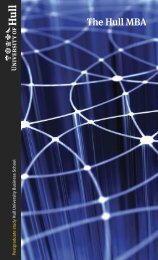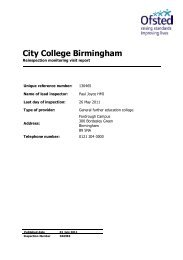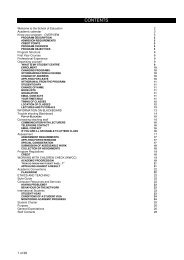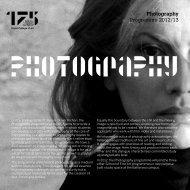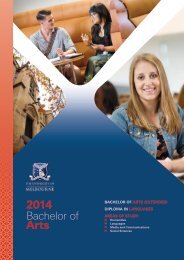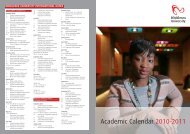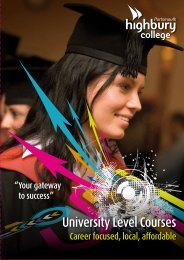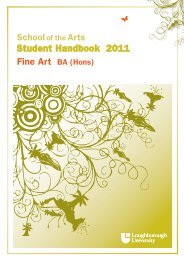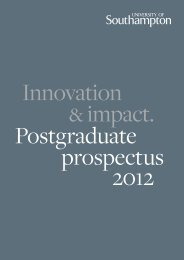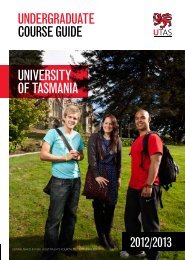Academic Calendar 2012/2013
Academic Calendar 2012/2013
Academic Calendar 2012/2013
You also want an ePaper? Increase the reach of your titles
YUMPU automatically turns print PDFs into web optimized ePapers that Google loves.
course Descriptions • course Descriptions • course Descriptions • course Descriptions • course Descriptions • course DescriptionsPHSD-103Physical Fitness3 Credits (30:15:0 hours)This is an experiential and lecture course to provide participants witha working understanding of health and physical fitness, as well as thebasic concepts for development and measurement. The interrelationshipof food, nutrition, weight and activity is studied, researched andevaluated on a personal basis.PHSD-301Scientific Analysis of the Golf Swing3 Credits (36:9:0 hours)Students learn both theoretical and practical knowledge relating to thegolf swing. The course focuses on the anatomical and physiologicalconcepts associated with the golf swing, biomechanical principlesnecessary to move the golf ball towards its target and physicalconditioning requirements for golfers.PHSD-391The Human Organism3 Credits (45:0:0 hours)This course is an introduction to human biology that analyzes thestructure and function of systems in our bodies. This course leads toan appreciation of how the human body maintains itself in the faceof external and internal challenges. A course for non-majors that willdevelop their understanding of the foundations of human healthand disease. Note: This course is only available to Disability StudiesProgram students. Credit can only be obtained in one of PEDS 391 orPHSD 391. Prerequisites: Biology 30.PHYS-020Physics 205 Credits (90:0:0 hours)Physics 20 is equivalent to Alberta Learning’s Physics 20. The coursedeals with major concepts of kinematics and dynamics, circular motion,universal gravitation, waves and light. Prerequisites: Science 10, Math 10or equivalent.PHYS-030Physics 305 Credits (90:0:0 hours)The material covered in this course is equivalent to Alberta Learning’sPhysics 30. Topics include conservation laws, electric and magneticforces and fields, the nature of the atom and wave-particle duality innature. Prerequisites: Physics 20 or equivalent.PHYS-108Introduction to University Physics I3 Credits (45:36:15 hours)This is an algebra based physics course for students without highschool physics. It includes the study of vectors, one and twodimensional kinematics and dynamics of particles and extendedobjects, conservation of energy and momentum, rotating systems,oscillations, and motion of fluids. During the course students develop aconceptual understanding of physical principles in classical mechanics,develop reasoning and problem-solving skills, and relate thesephysical principles to real-world situations. Note: This course is notavailable to students with Physics 30, and it is intended to be takenin sequence with PHYS 109. Credit can only be obtained in one ofPHYS 108 or PHYS 124 or PHYS 144 or ENPH 131. Prerequisites: PureMathematics 30.PHYS-109Introduction to University Physics II3 Credits (45:36:15 hours)Topics include the study of mechanical waves, properties of sound andlight waves, simple geometric optics, electric charge, electric currentsand circuits, magnetism, magnetic induction and transformers. Duringthe course the student develops a conceptual understanding of physicalprinciples and extend their reasoning and problem solving abilities tothe above areas. Note: Students with credit in PHYS 126 or PHYS 130or PHYS 146 may not receive credit in PHYS 109. This is an algebrabased physics course for students without high school physics intendedto be taken subsequent to PHYS 108.Prerequisites: Minimum grade of C- in PHYS 108.PHYS-124Particles and Waves3 Credits (45:36:0 hours)This is an algebra based physics course on motion of matter and wavesintended for students in life and medical sciences. Topics includekinematics. Newtonian mechanics, conservation of momentum andenergy, rotational motion, and statics and dynamics of extended bodies.Students also examine vibrations, waves, and a variety of interferencephenomena. At the end of the course, students are introduced toaspects of modern physics, such as relativity or quantum theory. Duringthe course students develop a conceptual understanding of physicalprinciples, develop reasoning and problem-solving skills, and relatethese physical principles to real-world situations relevant to biology andmedicine. Note: Physics 30 is strongly recommended. Credit can onlybe obtained in one of PHYS 108 or PHYS 124 or PHYS 144 or ENPH131. Prerequisites: Pure Mathematics 30 and Physics 20.PHYS-126Fluids, Fields and Radiation3 Credits (45:36:0 hours)This course follows PHYS 124 as an algebra-based physics course onfluids, electromagnetism and radiation. Topics include the static anddynamic behaviour of fluids, electrostatics, direct current circuits,magnetic fields, electromagnetic induction, alternating current circuits,nuclear structure and the interaction of nuclear radiation with matter.Note: Credit can only obtained in one of PHYS 109 or PHYS 126 orPHYS 130 or PHYS 146.Prerequisites: Minimum grade of C- in PHYS 124.PHYS-130Wave, Motion, Optics and Sound3.8 Credits (45:18:0 hours)This is a calculus based course intended for engineering students. Topicsinclude spherical mirrors, thin lenses, simple harmonic motion, wavemotion, interference, sound waves, light waves and diffraction. Note:Restricted to engineering students. Credit can only be obtained in oneof PHYS 109 or PHYS 126 or PHYS 130 or PHYS 146. Prerequisites:Pure Mathematics 30, Mathematics 31 and Physics 30. Co-requisites:MATH 100.352Grant MacEwan University • A C A D E m I CRefer to the Online Alberta Transfer Guide at www.transferalberta.ca for transfer opportunitiesC A L E N D A R <strong>2012</strong>/<strong>2013</strong> • www.MacEwan.ca



